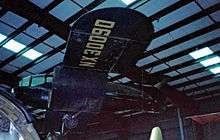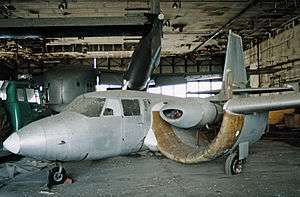Custer Channel Wing Corporation
| Aircraft design and manufacture | |
| Industry | Aircraft |
| Fate | Ceased operations |
| Founded | 1951 |
| Headquarters | Hagerstown, Maryland |
Key people | Willard Ray Custer |
The Custer Channel Wing Corporation was an American aircraft manufacturer that specialized in the design of aircraft utilizing the Channel wing. The company was active between 1951 and the 1970s.
Early history
Willard Ray Custer filed a United States patent in 1929 for a wing design incorporating a semi-circular channel or "half barrel" shape in which an engine was to be fitted in pusher mode. Custer claimed that this layout, the Custer Channel Wing, which gave STOL operating capabilities, resulted in a design "which is not an airplane. It does not plane the air to fly, rather it brings the air to the lift surfaces and reduces pressure to fly at 8 to 11 mph".[1]

The first aircraft to incorporate Custer's concept was the CCW-1 which was fitted with a single seat and powered by two 75 hp pusher engines. The sole example first flew on 12 November 1942.
Custer's next aircraft was the CCW-2 which was an evolution of the CCW-1 as a single-seat test bed using the adapted fuselage of a Taylorcraft BC-12 light aircraft, replacing the original single engine with two pusher engines fitted each side of the fuselage and placed within wing channels. The sole example first flew on 3 July 1948 and made many test flights totaling about 100 hours.
Formation of the corporation
Custer continued to develop his ideas for the Channel Wing and in 1951 he formed the Custer Channel Wing Corporation with a registered address at 1905 West Washington Street, Hagerstown, Maryland. It was reported that Taylorcraft Inc of Conway, Pennsylvania were the first manufacturers to be licensed for the production of both military and private aircraft using the Channel Wing principles.[2]
Design development
The first type to be produced on an experimental basis was to be a military aircraft to comply with United States Air Force specifications for a liaison aircraft. It was to carry a pilot and three fully equipped combat troops or 10 litter patients. Performance envisaged was 1,000 lb load, cruising at 150 knots or better over a five-hour cruise range.[3] In the event, Taylorcraft did not put the plans into action. A design had been prepared by early 1952 for a single-engined channel wing aircraft with the engine fitted in a single channel immediately behind the crew cabin.[4] This aircraft was not built. Design numbers CCW-3 and CCW-4 were not used.

Custer obtained some financial backing from various investors and proceeded with design of a larger five-person, twin-engined Custer CCW-5. The first example was built for Custer by the Baumann Corporation of Santa Barbara, California. It utilized an adapted fuselage and tail assembly of a Baumann Brigadier light twin-engined aircraft. Power was from two 225 hp engines and the CCW-5s first flight was made on 13 July 1953.[5] The CCW-5 accommodated five persons and was claimed to be capable of flying at a sustained speed of 35 mph.[6]
Custer persisted with his design and built a second CCW-5 at the CCWC factory, again using the fuselage and tail of a Baumann Brigadier. This aircraft first flew on 19 June 1964. Although several firms expressed interest in production of the design, all failed to provide sufficient funds.[7] In 1965, Custer and the Custer Channel Wing corporation were convicted of contempt of court for continuing to sell shares of the company after a 1962 SEC injunction. The CCW-5 continued to make development flights during the 1960s and 1970s, but no production orders were obtained. In 1978 Custer filed a $80 million suit against the designers of the A-10 for using his idea of induced lift from the proximity of the engines to the wings. The suit was dismissed.[8]
Preserved Custer aircraft
- CCW-1 NX30090 National Air and Space Museum store at Silver Hill, Maryland;[9]
- CCW-5 N5855V displayed at the Mid-Atlantic Air Museum at Reading Airport, Pennsylvania[10]
See also
References
Bibliography
- Green, William (1965). The Aircraft of the World. Macdonald & Co. (Publishers) Ltd.
- Ogden, Bob (2007). Aviation Museums and Collections of North America. Air-Britain (Historians) Ltd. ISBN 978-0-85130-385-7.
External links
| Wikimedia Commons has media related to Custer Channel Wing. |
- Listing of Custer designs with data and images
- "The Channel Wing" Flight International (4 January 1952): p.14
- Custer Channel Wing on Archive.org